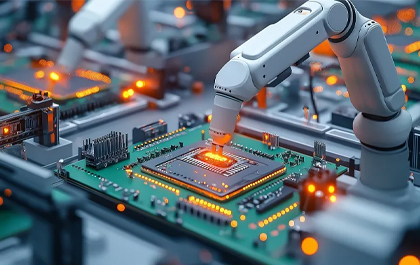There are many types of professional equipment for circuit boards (PCBs), covering all aspects of circuit board manufacturing. The following are some of the main equipment:
1. Inner layer production equipment of circuit board
1. Inner graphic transfer equipment
Laser Direct Imaging (LDI) equipment: used to directly expose line patterns on the photosensitive material on the inner layer of copper clad plate. Compared with traditional exposure methods, the accuracy is higher and more refined line production can be achieved. For example, in the production of high-density interconnect (HDI) circuit boards, LDI devices can produce lines with line width/pitch (L/S) up to 30μm/30μm or even smaller.
Exposure machine: The copper clad plate coated with photosensitive adhesive is exposed through ultraviolet (UV) light source, so that the photosensitive adhesive reacts photochemically in the pattern area to form a latent image of the line pattern. The accuracy of traditional exposure machines is also constantly improving, and is suitable for the production of inner layer graphics of multi-layer circuit boards.
Developing equipment: The exposed copper clad plate is processed through a chemical solution (development solution), and the unexposed photosensitive adhesive is removed to make the circuit pattern appear. The developing equipment needs to control parameters such as the concentration, temperature and spray pressure of the developer to ensure the clarity and accuracy of the circuit pattern.

2. Inner etching equipment
Etching machine: Use chemical etching solution (such as copper chloride, iron chloride and other solutions) to etch the copper foil on the copper clad plate that is not protected by photosensitive adhesive, leaving behind the copper circuit corresponding to the circuit pattern. The etching methods of the etching machine mainly include spray etching and immersion etching. Spray etching has the advantages of good etching uniformity, which can effectively avoid insufficient etching or over-etching, and ensure the quality of the line.
Film removal equipment: After the etching is completed, it is used to remove the remaining photosensitive adhesive on the circuit pattern to make the surface of the inner circuit board clean, and prepare for subsequent inner layer inspection and pressing and other processes.
3. Inner inspection equipment
Automatic optical detection (AOI) equipment: detects the circuit graphics of the inner circuit board through high-resolution cameras and image analysis software. It can quickly discover the open circuit, short circuit, line width deviation, copper slag and other defects of the line, and the detection accuracy can reach the micron level. AOI equipment can greatly improve the quality control level of the inner layer of the circuit board and reduce the error of manual inspection.
X - Ray inspection equipment: mainly used for quality inspection of the inner layer of multi-layer circuit boards, especially for the connectivity of inner layer lines and the inspection of buried holes, blind holes and other structures. It can penetrate the multi-layer structure of the circuit board, clearly display the inner circuit and hole, and detect defects hidden inside, such as the inner layer short circuit and insufficient copper thickness in the hole.
2. Circuit board drilling equipment
1. Mechanical drilling machine
CNC drilling machine: It is the main equipment for circuit board drilling, and the position and movement trajectory of the drill bit are controlled through the CNC system. Through holes of various apertures can be drilled on copper clad plates, such as the common apertures of 0.2 mm - 6.35 mm. Its drilling speed is fast, with high accuracy, and can be programmed according to the design requirements of the circuit board to realize batch drilling operations of multiple pore positions and different hole diameters.
高速钻孔机:专为提高钻孔效率而设计,转速可以达到每分钟数万转甚至更高。在生产大量需要钻孔的线路板时,高速钻孔机能够显著缩短钻孔时间,提高生产效率。同时,它还具备高精度的定位系统,确保钻孔位置的准确性。
2. Laser drilling equipment
Ultraviolet laser drilling machine: Use the high energy density of ultraviolet laser to drill micro-holes on copper clad plates. This device can drill micropores with diameters less than 100μm, and is suitable for the production of HDI circuit boards and some special circuit boards with very small hole size requirements. Ultraviolet laser drilling has the advantages of high accuracy and small heat-affected zone, which can effectively avoid damage to circuit board materials during drilling.
3. Circuit board outer layer production equipment
1. Outer graphics transfer equipment
Similar to inner-layer graphics transfer devices, they include LDI devices, exposure machines and developing devices. However, outer graphics may require higher accuracy and better surface treatment, as outer lines are directly connected to electronic components, requiring higher circuit quality and appearance.
2. External etching equipment and film removal equipment
Its working principle is the same as that of inner etching equipment and film removal equipment, but the etching parameters and film removal process control may be adjusted according to the characteristics of the outer line (such as the thickness of the outer line, surface roughness requirements, etc.).
3. Outer line surface treatment equipment
Electrochemical nickel/immersion gold (ENIG) equipment: A layer of nickel and gold are plated on the surface of the copper circuit through electroless plating. This surface treatment method can improve the oxidation resistance and solderability of the circuit. ENIG equipment includes electroless nickel plating tanks, gold immersion tanks and corresponding cleaning and drying equipment. It is necessary to control the composition, temperature, time and other parameters of the plating solution to ensure the quality of nickel plating/gold immersion.
Organic Weldability Protective Agent (OSP) equipment: used to form an organic protective film on the surface of the copper circuit to prevent oxidation of the copper circuit and ensure good solderability. OSP equipment mainly uses OSP solution to coat the surface of the circuit board through impregnation or spraying, and then forms a protective film through drying and other processes.
4. Circuit board forming equipment
1. CNC gong machine (CNC milling machine): The movement of the tool is controlled through a computer CNC system and the circuit board is cut into the required shape and size. Various special-shaped circuit boards can be processed, such as mobile phone circuit boards, computer motherboards and other complex shape circuit boards. During the cutting process, it is necessary to select appropriate tool and cutting parameters according to the material and thickness of the circuit board to ensure the cutting quality.
2. Punching machine: Use molds to stamp and mold circuit boards, suitable for forming circuit boards with regular shapes and large batches. The punching machine has a fast stamping speed, which can improve production efficiency, but the cost of the mold is relatively high and may not be suitable for circuit boards with complex shapes.
5. Circuit board assembly equipment (if the circuit board assembly process is involved)
1. SMD: used to accurately attach surface mount components (SMDs) to the specified position of the circuit board. The patch machine is divided into high-speed patch machine and high-precision patch machine. The high-speed patch machine is mainly used for the rapid mounting of a large number of components, while the high-precision patch machine is used for the components with extremely high requirements for mounting accuracy. Installation of devices (such as chips, etc.). The patch machine takes the components out of the tape or tray through the suction head, and then sticks the components in a predetermined position under the guidance of the visual system, and the mounting accuracy can reach ±0.05mm or even higher.
2. Reflow furnace: It is a device used to solder SMD components mounted on the circuit board to the circuit board. It melts the solder paste by heating, and then cools and solidifies, enabling the electrical connection between the components and the circuit board. The heating methods of reflow soldering furnaces include hot air heating, infrared heating, etc., and the temperature curve needs to be controlled to ensure welding quality. Different circuit boards and components may require different temperature profiles, so reflow furnaces need to have flexible temperature control functions.
3. Wave soldering equipment: mainly used for welding plug-in components. It uses melted soldering pins of component inserted into circuit board holes to wires on the circuit board. Wave soldering equipment needs to control parameters such as the height, speed and temperature of the solder wave peak. At the same time, the circuit board needs to be pretreated such as flux coating and preheating to ensure the quality and reliability of the solder.

 +86 138 2888 1856
+86 138 2888 1856 




